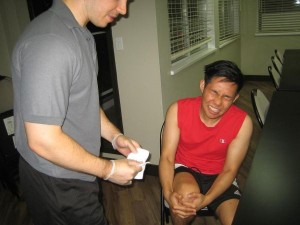 Knee injuries occur when there is a significant damage or trauma to the knee joint of the leg. Also considered the largest joint of the body, the knee connects the thighs to the lower legs. It allows the legs to flex and extend, enabling the legs to carry the body weight and allow vertical (jump) and horizontal (walking and running) movements.
Knee injuries occur when there is a significant damage or trauma to the knee joint of the leg. Also considered the largest joint of the body, the knee connects the thighs to the lower legs. It allows the legs to flex and extend, enabling the legs to carry the body weight and allow vertical (jump) and horizontal (walking and running) movements.
The knee joint is made up of bones, cartilages, ligaments and fluids. The muscles and tendons enable the knee joints to mobilize. Injuries to the knees are fairly common to all ages, affecting daily activities such as walking, running or even rising from chair.
Types of knee injuries
There are many different injuries that may occur to the knees. Some may affect the bones, tendons, ligaments or even cartilage of the knees, the last two being the commonly damaged structures. These may be sports-related injuries or minor falls or comes with old age.
- Ligament injuries: damages ligaments supporting the joint usually caused by twisting of the knee
- Anterior cruciate ligament (ACL)
- Lateral collateral ligament (LCL)
- Medial collateral ligament (MCL)
- Knee sprain
- Kneecap injuries: patella bone damages
- Runner’s knee
- Dislocated patella
- Patella fracture
- Cartilage injuries: damages cartilages lining the joint
- Torn cartilage knee injury
- Knee arthritis
Signs and symptoms of knee injuries
The sign and symptoms of knee injuries are dependent on the location, intensity of knee pain and the cause of the problem. Several signs and symptoms associated with knee injuries include:
- Pain, which may come and go
- Redness and swelling
- Stiffness
- Warm to touch
- Weakness
- Instability
- Popping and crunching noises
- Incapable of fully straightening the knee
When to see a doctor for knee injuries
It is strongly advised to call a doctor if
- Weight cannot be supported by the knee
- Marked swelling on knee
- Inability to fully straighten or extend the knee
- An evident deformation on the knee or leg
- High-grade fever
- Unstable knees
Knee injury treatment
Most injuries will require a trip to the doctor. However, if no operation is required, several treatments may be performed to alleviate pain and swelling, such as PRICE, sometimes accompanied by physical therapy.
- Protection: stop any physical activity and protect from further harm
- Rest: rest the injured area
- Ice: apply ice to the injured knee to reduce swelling
- Compression: a cold pack, compression sleeve filled with cold water or slush bath may be used
- Elevate: raise the injured knee about a foot
Apply ice packs for 15 minutes every few hours. If there is not rush to operate, it is strongly advised to strengthen the quadriceps and hamstring muscles to allow potential for easier post-operative therapy.
Knee injuries vary in treatment. However, it is necessary to apply basic first aid on knee injuries, if possible, to lessen the damage. First aid training is offered to teach the community on how to apply proper treatment for the various types of bones injuries, such as fractures, dislocations and different types of bone injuries.
